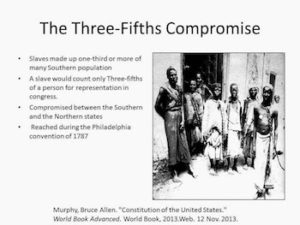
U.S. Constitution(copy)
On this date, in 1787, the Three-fifths Compromise was enacted. That year, delegates to the Constitutional Convention in Philadelphia accepted a plan determining a state’s representation in the U.S. House of Representatives.
It was ironic that a liberal northern delegate, James Wilson of Pennsylvania, proposed the Three-Fifths Compromise to gain southern support for a new framework of government. Southern states wanted representation apportioned by population; after the Virginia Plan was rejected, the Three-Fifths Compromise guaranteed that the Antebellum South would be strongly represented in the House of Representatives and have disproportionate power in electing Presidents.
The issue of how to count slaves split the delegates into two groups. The northerners regarded slaves as property who should receive no representation. Southerners demanded that Blacks be counted with whites. The compromise reflected the strength of the pro-slavery forces at the convention. The “Three-fifths Compromise” allowed a state to count three-fifths of each black person in determining political representation in the House. It was an early American effort to avoid the intersectionality of race, class, nationality, and wealth for political control.
Rather than halting or slowing the importation of slaves in the South, slavery had been given a new life, a political life. Even when the law stopped importing new slaves in 1808, the South continued to increase its overall political status and electoral votes by adding and breeding slaves illegally. The Three-fifths Compromise would not be challenged again until the Dred Scott case in 1856.